-
Tips for becoming a good boxer - November 6, 2020
-
7 expert tips for making your hens night a memorable one - November 6, 2020
-
5 reasons to host your Christmas party on a cruise boat - November 6, 2020
-
What to do when you’re charged with a crime - November 6, 2020
-
Should you get one or multiple dogs? Here’s all you need to know - November 3, 2020
-
A Guide: How to Build Your Very Own Magic Mirror - February 14, 2019
-
Our Top Inspirational Baseball Stars - November 24, 2018
-
Five Tech Tools That Will Help You Turn Your Blog into a Business - November 24, 2018
-
How to Indulge on Vacation without Expanding Your Waist - November 9, 2018
-
5 Strategies for Businesses to Appeal to Today’s Increasingly Mobile-Crazed Customers - November 9, 2018
Earth’s increasing vegetation quantified by remote sensing
The most comprehensive modelling of remote sensing data so far shows the area on Earth covered by plants in this time has increased by 18 million square kilometres – about 2.5 times the size of the Australian continent – largely due to the fertilising effect of carbon dioxide (CO2).
Advertisement
The team, using computer modeling to mimic plant growth observed in the satellite data, showed that while their research did not connect greening with plants’ carbon storage, other studies had previously reported growing carbon sink on land since the 1980s – aligned with the idea of a “greening Earth”. Experiments have shown that the Carbon dioxide fertilization effect is temporary.
High carbon emission has been noted as the instigator of this revitalization.
However, the researchres behind the new study said the impact of plants in reducing global warming in recent years by moping up carbon dioxide may now start to decrease. The concept is relatively simple; plants take in carbon to build their tissues, and if there is more carbon around, they have an easier time.
When there is more Carbon dioxide in the air, more sugars are produced, a process known as Carbon dioxide fertilization, and such “greening” of Earth has happened more in a quarter to one-half of the Earth’s vegetated lands, according to an analysis of data from the NASA-MODIS and NOAA-AVHRR satellite sensors of the past 33 years.
“The greening over the past 33 years reported in this study is equivalent to adding a green continent about two-times the size of mainland U.S. (18 million km2), and has the ability to fundamentally change the cycling of water and carbon in the climate system”, Dr. Zaichun Zhu, another of the study’s authors who is a researcher from Peking University, said in a statement.
As a result of the growth in recent decades, vegetation now covers nearly a third (32 percent) of the planet’s total surface area, occupying about 85 percent of all ice-free land.
“We were able to tie the greening largely to the fertilising effect of rising atmospheric Carbon dioxide concentration by tasking several computer models to mimic plant growth observed in the satellite data” says co-author Prof. Plants tend to employ carbon dioxide in the process of photosynthesis.
They found between one quarter to half of Earth’s vegetated lands has become significantly greener, caused by extra leaves on plants and trees.
The new study found other causes of the greening, including nitrogen from agricultural fertilisers. First, the many negative aspects of climate change are not acknowledged. The greening of the Earth has largely been accomplished through Carbon dioxide fertilization.
The authors of today’s study stress that the trend towards global greening over the past 30 years is not evidence that climate change is beneficial. Termed the Carbon Dioxide Fertilization Effect, it is surely a temporary phenomenon.
The lead author of the study on the greening of the Earth was Dr. Zaichun Zhu, a researcher from Peking University, China. In fact, it’s been taunted as an argument that burning fossil fuels is actually a good thing by climate change contrarians like Rupert Murdoch.
Advertisement
The lead author, Prof Ranga Myneni from Boston University, told BBC News the extra tree growth would not compensate for global warming, rising sea levels, melting glaciers, ocean acidification, the loss of Arctic sea ice, and the prediction of more severe tropical storms.





























